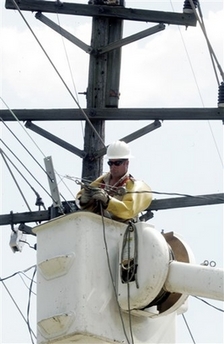Moving towards an underground utility line infrastructure in DC

In DC, in the so called L'Enfant City and Georgetown, Congress passed a law in the late 1800s that requires that utility lines be placed underground. This means that elsewhere in the city, there are above-ground powerlines, including in Brookland. Brookland residents are agitating and demonstrating for the utility lines on 12th Street to be placed underground during the soon to launch streetscape improvement project (see this for the plans from DDOT and this article from the Post, "Many Trees Do Not Grow in Brookland").
Pepco responded with cost estimates to do this of something like $22.5 million!!!!!!!!!!!!! when national averages tend to be about $1 to 1.5 million/mile.
Rachel M., formerly a ward transportation planner in DC, wrote this on a neighborhood list:
It seemed to me that the representatives from PEPCO and other utilities did their best to make the whole process seem as complicated and expensive as possible. I don't think it needs to be this way.
As I mentioned at the meeting, the reason many wires are underground in other parts of the city is the result of a number of federal statutes, dating from the 1880s and 1890s, prohibiting overhead wires in the historic parts of the city for aesthetic reasons.
I believe that City Council should similarly pass a law requiring PEPCO to underground their wires whenever DDOT is undertaking a major streetscape renovation project. This will ensure that PEPCO undertakes the work in the most cost effective way, and that DDOT dollars are available for the streetscape projects everyone wants.

Newton Theater, Brookland. Utility poles and wires on 12th Street NE are shown in the leftmost section of the photo.
Other parts of the city, including Pennsylvania Avenue in Hillcrest, Benning Road and Minnesota Avenue, and others, will be facing similar issues as DDOT projects move forward there. Councilmembers for these communities will have to deal with the same issues as Council member Thomas unless a more comprensive approach is taken.
In practice, the costs are likely to be much less than the inflated estimates PEPCO has provided, especially when the work is done in conjunction with a DDOT project. (The national average for this work appears to be about $1 million/mile. ) In addition to the federal precedent, there are many other communities around the country which have laws which similarly require utilities to pay for undergrounding wires for primarily aesthetic reasons.
With PEPCO paying for the bulk of the expense, there will then be the relatively minor expense of the costs of connecting from the property line to the building. Ordinarily, property owners would have to pick up these costs. However, as CM Thomas said, a Special Improvement District, encompassing both 12th Street and other parts
of the neighborhood, should be established instead to pool and pay for these costs so they are not borne by the property owners, many of whom are not in a strong position to pay.
I plan to write a longer letter to Councilmember Thomas this weekend detailing my ideas, and will share it with the group when I am done ...
---------------
Rachel's point that utility wires should be placed underground going forward as a matter of course, including during streetscape reconstruction projects is an important one.

AP photo.
Labels: urban design/placemaking



0 Comments:
Post a Comment
<< Home